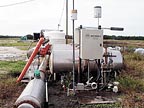

Pumps used for irrigation include centrifugal, deep well turbine, submersible and propeller pumps. Actually, turbine, submersible and propeller pumps are special forms of a centrifugal pump. However, their names are common in the industry. For our purposes here, the term centrifugal pump will refer to any pump located above the water surface and using a suction pipe.
Before selecting an irrigation pump, a careful and complete inventory of the conditions under which the pump will operate must take place. The inventory must include:
1. source of water (well, river, pond, etc.)
2. required pumping flow rate
3. total suction head
4. total dynamic head (TDH).
There usually is no choice when it comes to the source of the water; it is either surface water or well water, and availability will be determined by the local geology and hydrologic conditions. However, the flow rate and total dynamic head will be determined by the type of irrigation system, the distance from the water source and the size of the piping system.
Pump Selection Criteria
The selection of an irrigation water pump is based almost entirely on the relationship between pump efficiency and the TDH the pump will provide at a specific flow rate. The table below can be used to narrow the selection of a pump type for a broad range of flow rates and total dynamic heads. One item not included in the TDH values in the table is the suction lift. If your application needs to lift the water to the pump, a centrifugal pump will have to be used.
Some factors to be considered when selecting an irrigation pump:
Centrifugal Pumps
Advantages
- High efficiency over a range of operating conditions.
- Easy to install.
- Simple, economical and adaptable to many situations.
- Electric, internal combustion engines or tractor power can be used.
- Does not overload with increased TDH.
- Vertical centrifugal may be submerged and not need priming.
Disadvantages
- Suction lift is limited; it needs to be within 20 vertical feet of the water surface.
- Priming required.
- Loss of prime can damage pump.
- If the TDH is much lower than design value, the motor may overload.
Vertical Turbine Pumps
-
Advantages
- Adapted for use in wells.
- Provides high TDH and flow rates with high efficiency.
- Electric or internal combustion power can be used.
- Priming not needed.
- Can be used where water surface fluctuates.
Disadvantages
- Difficult to install, inspect and repair.
- Higher initial cost.
- To maintain high efficiency, the impellers must be adjusted periodically.
- Repair and maintenance is more expensive.
Submersible Pumps
Advantages
- Can be used in deep wells.
- Priming not needed.
- Can be used in crooked wells.
- Easy to install.
- Smaller diameters are less expensive.
Disadvantages
- More expensive in larger sizes.
- Only electric power can be used.
- More susceptible to lightning.
- Water movement past motor is required.
Propeller Pumps
Advantages
- Simple construction.
- Can pump some sand.
- Priming not needed.
- Efficient at pumping very large flow rates at low TDH.
- Electric, internal combustion engine and
tractor power can be used.
- Suitable for portable operation.
Disadvantages
- Not suitable for suction lift.
- Cannot be valved back to reduce flow rate.
- Intake submergence depth is very critical.
- Limited to low (<75 ft.) TDH.
Report Abusive Comment